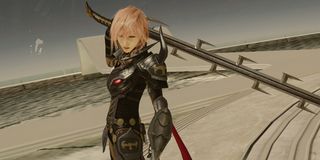
If you haven't played the previous Final Fantasy XIII games, there's a good chance that you won't like Lightning Returns. If you have played the previous games, there's a good chance you still won't like it. Square Enix has made some bold changes to the gameplay and unfortunately not all of them work.
The plot is a hot mess. If you're a newcomer, you should watch the recap video to get caught up on the events of the first two FFXIII games. You still might be lost within minutes of starting this latest chapter, though. Lightning Returns heaps loads of theology on you without anything human or engaging to balance it out. I could care less about the perpetually pissed-off Lightning or her friends.
If you zoom out far enough, though, the story sounds interesting. Lightning has woken up from a 500-year slumber by God. She's been chosen to be the world's savior. It's her job to save as many souls as possible in 13 days before the world ends.
The countdown to the apocalypse is a central part of the game. As Lightning explores Nova Chrysalia, the clock ticks away. Certain sidequests and areas will only be available at specific time periods. You might not be able to save everyone before time runs out. Who. Will. You. Save.
Again, the premise is better than the execution. The actual process of saving souls is tedious. The quests have paper-thin plots and at their core are merely fetch or kill quests. The running clock can't disguise their simplicity. I'm also not really sure how grabbing an item saves someone's eternal soul.
I could forgive the poor side quests if they could be ignored in favor of the main story. However, they're actually important. You don't level up through combat so the only way to raise Lightning's stats is to plow through these monotonous tasks.
While the game allows you to freely explore Nova Chrysalia's regions, there's not much incentive to do so. Whenever I wandered off into zones away from my current objectives, I encountered monsters that I could barely scratch. Though Lightning can jump and climb, there's little for her to find above street level besides the occasional chest or invisible walls. The game world feels more like a collection of corridors than a coherent world. In many cases, it's not even pleasant to look at.
CINEMABLEND NEWSLETTER
Your Daily Blend of Entertainment News
Combat sounds like it would be a disaster, too. Players control only Lightning rather than a party of characters. They directly move her with the analog stick and perform her abilities with face buttons.
Just from that description, you'd assume that Square Enix had dumbed down the combat to win over hack-and-slash fans. The battles are more complex than they appear at first blush, though. Lightning can be equipped with three different sets of equipment and abilities called Schemata. For example, one Schemata could turn her into an offensive mage while another could make her a sturdy tank. Lightning is three different party members in one in this game.
Each Schemata has its own ATB gauge and you can switch between them in real-time. Success in combat is a matter of timing your switches right so you can land a series of successive blows and stagger your enemies for big damage. You need to time your blocks just as carefully to minimize damage. You also have to decide when to use your Energy Points, a limited resource that can be spent on healing yourself, stopping time and other powerful effects.
The sloppy execution of Lightning Returns makes it easy to say goodbye to Lightning. The battle system is really something special, though, and I hope it returns in a later Final Fantasy game. It's a great feature hidden in a pile of bad ones.
Players: 1
Platforms: Xbox 360 (reviewed), PS3
Developer: Square Enix, tri-Ace
Publisher: Square Enix
ESRB: Teen
Rating:







Staff Writer at CinemaBlend.

The Masked Singer’s Clay Aiken And Ruben Studdard Clear The Air About Alleged Feud When They Were On American Idol

How The Legend Of Zelda Movie Director Is Approaching Fan Passion And Ideas In The Run-up To The Video Game Blockbuster

I Just Found Out Selena Gomez Binges Friends On Her Day Off, And She's 100% My Kindred Spirit
Most Popular




